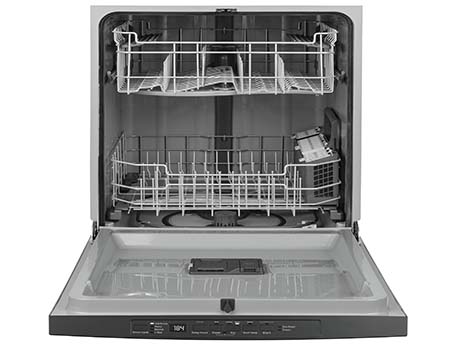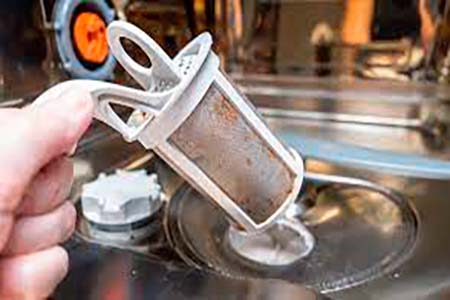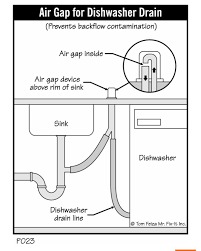Common Causes of a Smelly Dishwasher
Wondering why is your dishwasher smells bad? There are several factors that can cause your dishwasher to smell, including:
- Food Debris: Unwanted smells can develop due to the accumulation of leftover food particles in hard-to-reach areas.
- Grease Buildup: Grease from dishes can coat the dishwasher’s interior, creating a breeding ground for odor-causing bacteria.
- Mold and Mildew: Moisture within the dishwasher can create an environment conducive to the development of mold and mildew.
Supplies
To start this task of eliminating unpleasant odors, make sure you have the necessary supplies and tools to effectively address both dishwasher odors and drainage problems.
Supplies:
- Baking soda: is a versatile and naturally occurring cleaning agent that possesses a wide range of uses.

- White vinegar: A powerful odor remover and cleaner.
- Soft brush or toothbrush: Ideal for scrubbing hard-to-reach areas.
- Screwdriver: Necessary for disassembling certain dishwasher parts.
- Dishwasher Detergent: Select a high-quality dishwasher detergent to achieve the best cleaning results.
- Rubber gloves: Protect your hands during maintenance tasks.
Tools:
- A bucket: Handy for collecting water and debris.
- A clean cloth or sponge: Used for wiping and cleaning.
- A flashlight (optional): Helps you inspect hidden areas within the dishwasher.
Identifying and Fix the Source of the Bad Smell
When you open your dishwasher, the last thing you want to encounter is a foul odor wafting from inside. However, a smelly dishwasher is a common issue that many homeowners face. You’ll be glad to know that once you pinpoint the origin of the unpleasant odor, you can take specific measures to get rid of it and have a clean and fresh-smelling dishwasher. So, let’s roll up our sleeves and start the detective work. Here’s how to identify the source of that unwelcome aroma:
To check for the Dishwasher Interior
Now, let’s focus on the inside of the dishwasher. Over time, food particles and moisture can build up on different surfaces within the appliance, leading to an unpleasant smell. Here are some steps you can take to thoroughly examine and clean the interior of your dishwasher:
- Check the Door Gasket: The door gasket on a dishwasher is a rubber seal that is located around the edges of the door. Its primary function is to establish a tight seal that prevents water from leaking during the dishwasher’s cycles. Unfortunately, this seal can also trap moisture and food
 particles, leading to unpleasant odors. To check and clean the door gasket:
particles, leading to unpleasant odors. To check and clean the door gasket: - Check for Debris: Thoroughly inspect the door gasket to identify any noticeable grime, leftover food particles, or signs of mold development. It’s important to focus on the folds and creases of the gasket, as these areas are tend to debris gathering.
Solutions:
- Clean with a Damp Cloth: Wipe the entire door with a damp cloth or sponge.
- Wipe Down the Interior: The interior of the dishwasher, including the tub, walls, and corners, can accumulate food residues and moisture over time. Here’s how to inspect and clean these surfaces:
- Use a Clean Cloth or Sponge: Take a clean cloth or sponge and dampen it with warm water. Wipe down all interior surfaces of the dishwasher, paying special attention to corners and crevices where debris can accumulate.
- Check the Spray Arms: While you’re cleaning the interior, inspect the spray arms for any remaining debris or residues. Ensure that the spray arm nozzles are clear and free from obstructions.
- Leave the Door Ajar: After cleaning, consider leaving the dishwasher door slightly ajar when it’s not in use. This allows moisture to evaporate, helping to keep the interior dry and odor-free.
Thoroughly cleaning the inside of your dishwasher will remove food particles and wetness that can cause bad odors. This step is essential to keep your dishwasher smelling fresh.
To check for food debris:
- Remove the bottom basket: First, pull out the bottom basket of the dishwasher. This will give you access to the floor area where food particles collect.
- Inspect the Sump Area: The sump area is where water is collected and pumped back into the dishwasher during the wash cycle. Check for any food debris or foreign objects in this area.
Examine the Spray Arms: During the wash cycle, water is collected in the sump area and pumped back into the dishwasher. look around sump area for any food scraps or foreign objects.
Solution:
- Disconnect the Dishwasher: Safety first. Before attempting any repairs, disconnect the dishwasher from the power source. You can unplug it or turn off the circuit breaker.
- Inspect the Drain Hose: Carefully examine the drain hose for any visible blockages or kinks. Follow the hose from the dishwasher to where it connects to the drain system.
- Remove Blockages: If you spot any debris or obstructions, remove them gently. You can use a long brush, pipe cleaner, or even a bent coat hanger to reach and clear blockages. Ensure the hose is free and clear.
- Reconnect the Drain Hose: After clearing any obstructions, securely reconnect the drain hose to both the dishwasher and the drain point. Ensure there are no kinks or sharp bends in the hose.
- Test the Dishwasher: Plug the dishwasher back in or turn on the circuit breaker. Run a test cycle to verify that the drainage issue is resolved. During the cycle, monitor the drainage to confirm that water flows freely.
Cleaning the Dishwasher Filter
The filter in your dishwasher is one of the most important parts for odor control. Filters are used in dishwashers to accumulate food particles and stop them from returning to your dishes. These filters may clog up with time, producing odors. The filter can be examined and cleaned as shown here:
- Locate the Filter: The filter is typically located at the bottom of the dishwasher, beneath the lower spray arm. Its exact location may vary
 depending on your dishwasher model.
depending on your dishwasher model. - Remove the Filter: You might have to turn or lift the filter to remove it, depending on the design of your dishwasher. If you’re unsure of how to do this, consult the dishwasher’s handbook.
Solutions:
- Rinse the Filter: Once you’ve removed the filter, take it to the sink and rinse it thoroughly under warm running water. This will help remove any loose debris and food particles that have accumulated.
- Use a Soft Brush or Toothbrush: If the filter is extremely filthy or contains more difficult-to-remove debris, you can use a soft brush or toothbrush to gently clean the filter. For complete cleanliness, pay particular attention to all the surfaces and crevices.
- Soak if Necessary: If you notice that the filter is particularly dirty or has a lingering odor, you can soak it in a mixture of warm water and mild dish soap for about 10 minutes. This can help break down and remove built-up residue.
- Reassemble the Filter: After the filter has been thoroughly cleaned and cleared of any debris, reinstall it and put it back in the dishwasher where it belongs. Make sure it is firmly positioned.
Checking the Drainage System
One of the prime suspects behind a smelly dishwasher is the drainage system. If it’s not functioning correctly, water may not be draining as it should, leading to stagnant, odor-producing pools. Here’s how to investigate and address drainage system issues:
- Inspect the Drain Hose: Start by examining the drain hose, which is typically located at the back of the dishwasher. Ensure it’s not kinked or bent, as this can impede water flow. If you notice any visible obstructions or kinks, carefully remove them.
- Check the Garbage Disposal Connection: If your dishwasher is connected to a garbage disposal unit, a blockage or malfunction in the disposal can affect drainage. Turn off the power to the garbage disposal, inspect it for debris or clogs, and clear any obstructions you find.
- Examine the Air Gap: Dishwashers often have an air gap device installed to prevent backflow of water. Inspect the air gap for any clogs or
 obstructions. Clean it thoroughly to ensure proper drainage.
obstructions. Clean it thoroughly to ensure proper drainage. - Inspect the Drain Pump: The drain pump is responsible for pumping out water at the end of each cycle. A failed pump or damaged impeller will not effectively remove water from the device. Check the pump for visible damage and test functionality with a multimeter if necessary. If the pump is defective, it may need to be replaced.
- Verify High Loop Installation: In some installations, a high loop in the drain hose is necessary to prevent backflow from the sink into the dishwasher. Ensure that this high loop is correctly set up and that the hose is secured to prevent sagging or drooping.
Solutions:
- Clean the Dishwasher Filter: Clean your dishwasher filter: The clogged dishwasher filter can restrict water flow and prevent drainage. Locate the filter, usually at the bottom of your dishwasher, and give it a thorough clean.
- Inspect the Drain Solenoid: The drain solenoid controls the drain valve. If it’s damaged or not working correctly, it can result in drainage problems. Inspect the drain solenoid for visible damage and test it for continuity using a multimeter if needed.
After performing these checks and addressing any issues you find, run a test cycle to ensure that your dishwasher drains properly. If the problem persists, it may be time to seek professional help or consider more extensive troubleshooting.
Stay tuned for the next steps in our guide as we continue to identify and fix the sources of bad smells in your dishwasher, guaranteeing a kitchen free from unpleasant odors.
Preventing Future Drainage Problems
Now that you’ve successfully resolved the drainage issue in your dishwasher, it’s crucial to take steps to prevent similar problems from occurring in the future. Here are some preventive measures you can implement to keep your dishwasher running smoothly:
- Regularly Clean the Filter: Make it a habit to clean the dishwasher filter regularly, ideally once a month. Removing debris and food particles from the filter helps maintain proper water flow and drainage.
- Scrape Plates Before Loading: Before placing dishes in the dishwasher, scrape off excess food particles into the trash or compost bin. This simple step can significantly reduce the amount of debris that enters the dishwasher.
- Rinse Dishes Lightly: While modern dishwashers are designed to handle dirty dishes, a quick rinse under the tap can help remove stubborn food residues and prevent them from clogging the dishwasher’s drain system.
- Use High-Quality Dishwasher Detergent: Choose a reputable dishwasher detergent that is suitable for your dishwasher model. Using the right detergent can prevent residue buildup that may contribute to drainage problems.
- Run Hot Water Before Starting the Dishwasher: Before starting the rinse cycle, run hot water from the faucet until hot. This will force the dishwasher to start the cycle with hot water, improving cleaning performance and flow.
- Perform Regular Maintenance Checks: Schedule periodic checks of your dishwasher’s drain hose, drain pump, and filter to ensure they remain clean and free from obstructions. Catching and addressing potential issues early can prevent larger problems from developing.
- Avoid Overloading: While it may be tempting to maximize your dishwasher’s capacity, overloading it can impede water flow and drainage. Follow your dishwasher manufacturer’s guidelines for loading dishes properly.
When to Seek Professional Help
In most cases, the steps outlined in this guide should help you resolve common dishwasher drainage issues. However, there are situations in which it’s advisable to seek professional assistance:
- Persistent Drainage Problems: If you’ve attempted the troubleshooting steps, but your dishwasher continues to experience drainage problems, it may indicate a more complex issue that requires professional diagnosis and repair.
- Electrical or Mechanical Malfunctions: If you suspect that the problem is related to an electrical or mechanical component of your dishwasher, such as the drain pump or solenoid valve, contact a qualified appliance repair technician. It is best to inquire.
- WarrantyConsiderations: If your dishwasher is still under warranty, attempting DIY repairs may void the warranty. Check your warranty documentation and consider contacting the manufacturer or an authorized service provider for assistance.